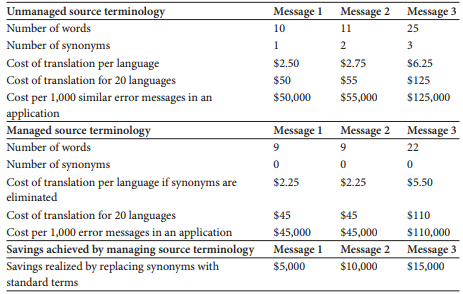- 签证留学 |
- 笔译 |
- 口译
- 求职 |
- 日/韩语 |
- 德语
Let us consider a hypothetical example that illustrates how the failure to manage source terminology can directly impact costs associated with error messages. Suppose three developers working for the same software company each write an error message to the effect that a program has experienced a problem and must stop running. The developers work in different parts of the building and are working on different modules of code for the same program. Because no mechanism exists to standardize the terminology they use, each developer authors his or her own individual error message without stopping to consult with others, which leads to three different variations (see Figure 1).

Figure 1. Three error messages describing the same problem.
Even though these three error messages describe the same problem, they are written differently and use different terms to describe the same concepts. Neither the localizer nor the user of the U.S. product will necessarily know that these three messages are reporting the same error. Similarly, in all likelihood they will not know that what follows "Click OK to" represents the same concept in each message. What started out as the same idea in three developer's heads becomes a source of cognitive dissonance to the typical user and a tangle of potential synonyms to the localizer.
Software companies typically calculate translation costs by the word, at an approximate average cost (across many different languages) of $0.25 per word. Table 1 provides an approximate translation cost breakdown for each error message given various conditions. It quickly becomes clear that the more languages a given piece of software is translated into, the larger the impact of unmanaged terminology. If, in this example, terminology were standardized by eliminating synonyms, costs would be reduced. For example, instead of using error, internal error, and severe error, all three messages could use error. By the same token, all three messages could use program instead of function and application, and close instead of quit, end, and terminate. By eliminating synonyms, a company could take advantage of the lower costs of recycling terms that have already been localized in a similar context. The table also indicates the relative translation costs that would be incurred if each of the three developers wrote 1,000 similar error messages, as well as the cost reduction that could be achieved by eliminating synonyms in those error messages in favor of standardized terms.
No matter how many error messages a company generates, it clearly spends more on translation if it does not manage their terminology. Of course, the best solution is to simply pick one error message for each possible program fault type and reuse it, saving potentially thousands of dollars in localization costs (not to mention the money saved by not writing and editing each different error message in duplicate, triplicate or worse).
Table 1. Error message localization savings achieved by terminology management.

What happens in the software development life cycle when no one is in charge of managing most or all of the source terminology and why is that such a terrible thing? Terminology can quickly become inconsistent within and across products, and source- and target-language glossaries can become filled with competing definitions. This can make products more difficult to use. For example, several years ago Microsoft designed and marketed two enterprise server products that were engineered to work together. However, the source terminology for the two products was developed separately. This resulted in competing term pairs such as link state database versus link state table and container versus container object. Even by comparing the source glossary definitions the non-expert could not determine whether these should be considered to be synonyms. Localizers probably had no choice but to consider them as separate concepts and translate accordingly.
If only a few terms in software products needed to be documented, perhaps unmanaged source terminology wouldn't be such a problem. But language plays a critical role in our ability to learn and master a computer program - if terms are not consistent then the program becomes harder for us to use. In addition, new technology and new concepts call for new terms. The terminology set for software will only become larger as programs become more ubiquitous and complex.
责任编辑:admin
